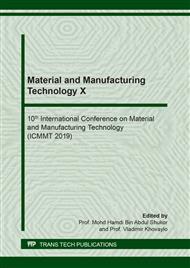[1]
A. Gregor, E. Filova, M. Novak, J. Kronek, H. Chlup, M. Buzgo, et al., Designing of PLA scaffolds for bone tissue replacement fabricated by ordinary commercial 3D printer,, J Biol Eng, vol. 11, p.31, (2017).
DOI: 10.1186/s13036-017-0074-3
Google Scholar
[2]
T. Serra, M. Ortiz-Hernandez, E. Engel, J. A. Planell, and M. Navarro, Relevance of PEG in PLA-based blends for tissue engineering 3D-printed scaffolds,, Mater Sci Eng C Mater Biol Appl, vol. 38, pp.55-62, May 1 (2014).
DOI: 10.1016/j.msec.2014.01.003
Google Scholar
[3]
H.-M. Yin, J. Qian, J. Zhang, Z.-F. Lin, J.-S. Li, J.-Z. Xu, et al., Engineering Porous Poly(lactic acid) Scaffolds with High Mechanical Performance via a Solid State Extrusion/Porogen Leaching Approach,, Polymers, vol. 8, p.213, (2016).
DOI: 10.3390/polym8060213
Google Scholar
[4]
A. Golshan, J. A. Curtis, V. Lianos, S. Y. Rabbany, and R. C. de Guzman, Compressive strengths of PEG gels with glycerol and bioglass particles,, bioRxiv, (2018).
DOI: 10.1101/405779
Google Scholar
[5]
Y. Xu, D. Luong, J. M. Walker, D. Dean, and M. L. Becker, Modification of Poly(propylene fumarate)-Bioglass Composites with Peptide Conjugates to Enhance Bioactivity,, Biomacromolecules, vol. 18, pp.3168-3177, Oct 9 (2017).
DOI: 10.1021/acs.biomac.7b00828
Google Scholar
[6]
L. L. Hench, The story of Bioglass®,, Journal of Materials Science: Materials in Medicine, vol. 17, pp.967-978, November 01 (2006).
Google Scholar
[7]
A. A. Gorustovich, J. A. Roether, and A. R. Boccaccini, Effect of bioactive glasses on angiogenesis: a review of in vitro and in vivo evidences,, Tissue Eng Part B Rev, vol. 16, pp.199-207, Apr (2010).
DOI: 10.1089/ten.teb.2009.0416
Google Scholar
[8]
D. Bellucci, A. Sola, R. Salvatori, A. Anesi, L. Chiarini, and V. Cannillo, Sol-gel derived bioactive glasses with low tendency to crystallize: synthesis, post-sintering bioactivity and possible application for the production of porous scaffolds,, Mater Sci Eng C Mater Biol Appl, vol. 43, pp.573-86, Oct (2014).
DOI: 10.1016/j.msec.2014.07.037
Google Scholar
[9]
F. T. M. Noori and N. A. Ali, Study the mechanical and thermal properties of biodegradable polylactic acid/poly ethylene glycol nanocomposites, International Journal of Application in Engineering of Management, vol. 3, Jan (2014).
Google Scholar
[10]
T. Kokubo and H. Takadama, How useful is SBF in predicting in vivo bone bioactivity?,, Biomaterials, vol. 27, pp.2907-15, May (2006).
DOI: 10.1016/j.biomaterials.2006.01.017
Google Scholar
[11]
J. Faure, R. Drevet, A. Lemelle, N. Ben Jaber, A. Tara, H. El Btaouri, et al., A new sol-gel synthesis of 45S5 bioactive glass using an organic acid as catalyst,, Mater Sci Eng C Mater Biol Appl, vol. 47, pp.407-12, Feb (2015).
DOI: 10.1016/j.msec.2014.11.045
Google Scholar
[12]
B. Chieng, N. Ibrahim, W. Yunus, and M. Hussein, Poly(lactic acid)/Poly(ethylene glycol) Polymer Nanocomposites: Effects of Graphene Nanoplatelets,, Polymers, vol. 6, pp.93-104, (2013).
DOI: 10.3390/polym6010093
Google Scholar
[13]
A. Stamboulis, L. L. Hench, and A. R. Boccaccini, Mechanical properties of biodegradable polymer sutures coated with bioactive glass,, Journal of Materials Science: Materials in Medicine, vol. 13, pp.843-848, September 01 (2002).
DOI: 10.1023/a:1016544211478
Google Scholar
[14]
S. Gholami, et al., Long term effects of bioactive glass particulates on dental pulp stem cells in vitro, Biomedical Glasses 3(1): 96-103.
DOI: 10.1515/bglass-2017-0009
Google Scholar


